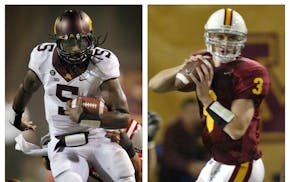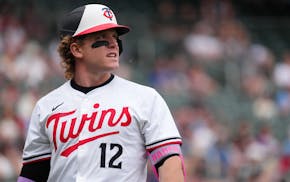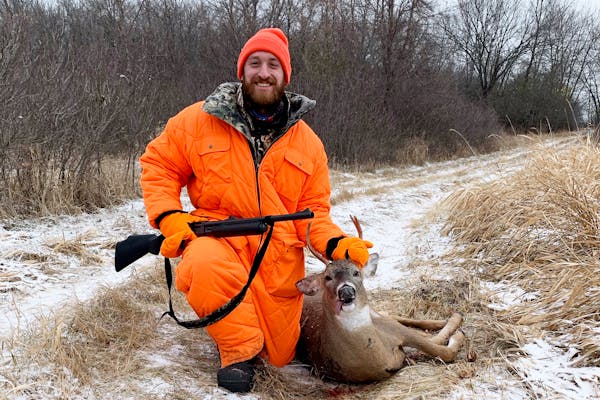Beneath his signature cattleman's hat, Marshall Johnson is always thinking, particularly about ranchers and farmers, who he believes will play — must play — critical roles in restoring grassland bird populations in Minnesota and beyond that have declined in staggering numbers.
And the message hasn't changed since his time as vice president-executive director at Audubon Dakota and up the ranks to his new job as the National Audubon Society's conservation chief.
The conservation ranching ethos Johnson energized in the Dakotas connecting food production with birds has grown a wider audience with his ascent at Audubon, which is recognizing ranchers for regenerative practices such as timing and targeting their livestock grazing to help cultivate rather than diminish habitat birds need to survive. Grassland species such as the prairie chicken and the bobolink have declined by 40% since 1946, according to Audubon, and are among the most vulnerable of any species. Audubon's Conservation Ranching Initiative has almost 4 million acres activated in 16 states and is looking to expand.
What's in it for ranchers and farmers? Recognition as a bird-friendly beef producer to an environmentally conscious consumer. A message of partnerships tracks with Johnson's appearance in Minneapolis last week to speak at Northrop Auditorium on the University of Minnesota campus about climate solutions. It was familiar ground — Johnson is a Minnesota Crookston business alum and former systemwide student senator.
"Birds are imploring us to take action on climate now," he said by phone ahead of his presentation. "… Maybe it is because I am a millennial, but I am bullish on our agency and ability to affect change."
In the interview below, Johnson talked about conservation farming and its new place in the Audubon playbook, which has traditionally focused its grassland strategy on volunteer protection, and other topics.
You and Audubon have a big constituency from ranchers to hunters to businesses to policymakers, and you want to even the playing field in the birding community and have more people of color see themselves as partners and participants. How do you approach such a large task?
My mentor, Dr. John Challey, would always tell me, "Marshall, focus is the main component of genius." I think we all have a role to play. For Audubon, our focus on climate change and biodiversity loss, we have a focus around helping drive bird-friendly siting of renewable energy and committing to a proactive goal of helping meet the goals around renewable energy. We need 300 gigawatts of renewable energy in the coming years and we want to be part of that deployment.
Secondly, we have lost 3 billion birds since 1970. We have to solve for climate change, but we also have to restore habitat at scale to recover bird populations in North America. Nature-based solutions afford us an incredible opportunity to both enhance the ability of landscapes and ecosystems to support bird life but also put carbon in the ground where it is used in a positive way within the natural carbon cycle, instead of in the atmosphere.
We are looking to mobilize our 1.9 million members, our 17 state and regional offices, and international programs. We have a footprint in the boreal forest all the way down to Chile. There are 47 million [birders] that are passionate and can be activated and engaged to lead on key initiatives on climate change and biodiversity loss, and our time is now.
Conventional conservation can't keep up with the demise of grassland habitat … that is part of the narrative behind your conservation farming/ranching strategies.
Absolutely. Nature-based solutions — many of them are practices. To supercharge those practices, we have to make sure we are being bold when it comes to food. There is a great quote [that says] "Every time you spend a dollar, you are casting a vote for the world you want to live in." Regenerative agriculture affords a lot of promise to retool our food system to benefit farmers, ranchers, us as consumers and, most importantly, the landscape and ecosystems. We have to get it right. Regenerative agriculture and good food can't just be available for people who can shop at Whole Foods. It has got to be available to everyone. There is a process to get there. We have to be mindful of regenerative agriculture being a big tent with equity and access and inclusion at its core, given that so many principles are derived from ecological knowledge and Indigenous land stewardship.
We have to protect more. We have to conserve more. Those efforts, even at scale, we can fall short. We have to be creative, and I think centering conservation in the production of food in a more deliberate way can be a win-win-win for farmers, ranchers, ecosystems and growing better food. We have to scale our conventional approaches — they work — but we also have to design catalysts for a greater scale that meets the challenges, particularly in the prairie wetland ecosystem.
How about plans for Minnesota?
The Driftless and [tallgrass] aspen parkland prairies out west. The glacial ridges … that is where I fell in love with birds and conservation. We are going to be expanding through partnerships into Minnesota with our bird-friendly beef program.
From Teddy Roosevelt forward, the message in the hunting community is that hunters are among the most ardent conservationists, given that their participation funds all sorts of wildlife protection and programs. As a bird hunter and a bird protector, how do those ideas coexist inside you?
For me, it is really about passion. I consider myself to be a birder. I also am a bird hunter. For me, what draws me into nature could be a project that we are working on. It could be a special rare bird that has come across the wire close to where I am out. But many times, it is being out and scouting and hunting and really enjoying that experience. It is not a bloodlust for killing things; it really is being immersed in nature in that unique way. That is not to say it is more special or less than being immersed as a birder. It is just different, and I just enjoy the full spectrum.
Do the roots go deep?
They don't. My grandfather never gave me a shotgun. Like a lot of folks who grow up in the inner city like I did, my association with guns was very different. There, for me, it was a stigma. It was college and after college through friendships that I took down some of the stigmas and appreciated hunting equipment in a different way.
It is important that we, whether it is the hunting community or the birding community, reach into communities like those that I came from.
Your cattle hat suits you. Maybe it's become your signature?
[Laughs] I have people comment on it quite a bit. It's probably not something that you see in downtown Minneapolis much. I think of the Willie Nelson song, "My Heroes Have Always Been Cowboys." It was something that I was drawn to at a young age in Texas. There were Black guys with cowboy hats, white guys, brown guys. It is part of living there and has always been with me. Working with hundreds of farmers and ranchers, I would never wear my hat around them. I'd pull up into driveways and down prairie trails … I would always take my hat off and put on a ball cap. it wasn't for years until this sort of happenstance and one of the ranchers saw me with my hat on and said that hat looks good on you. Why don't you wear it all the time? Ranchers have always encouraged me to wear it more. It wasn't something I did to help me get the work I was doing. I would say it is very much me.
(This interview was edited for length and clarity.)

Former Gophers football standouts embrace being basketball dads

Reusse: Once-formidable Twins starting rotation vulnerable without López

Twins lose second in a row to Blue Jays as bullpen falters late
What is the 'House settlement,' and what does it mean for the Gophers and NCAA?

